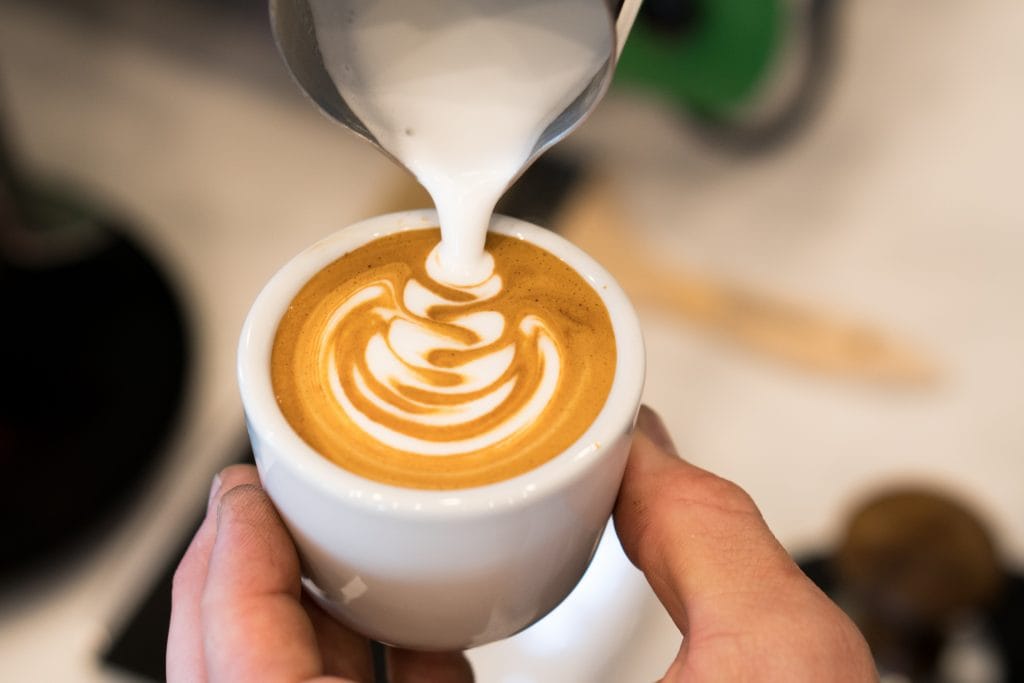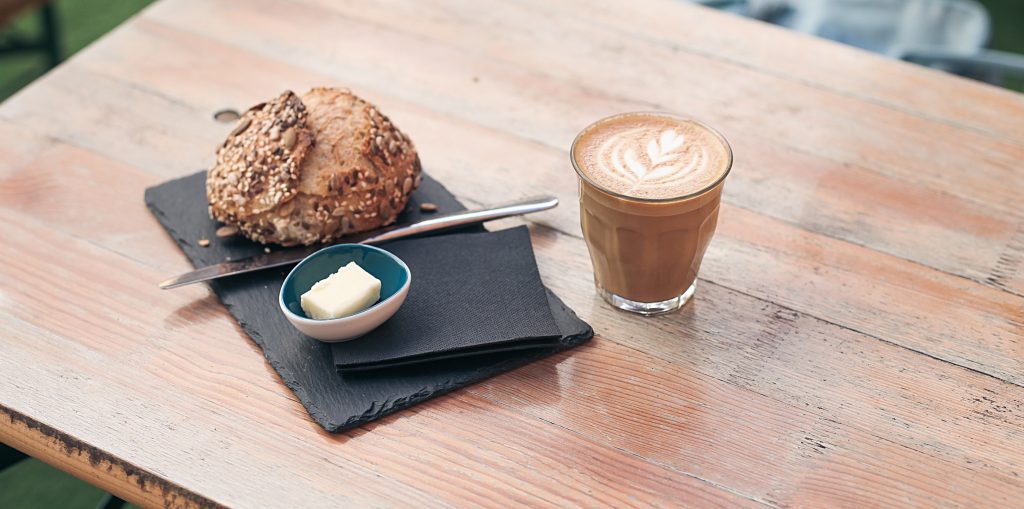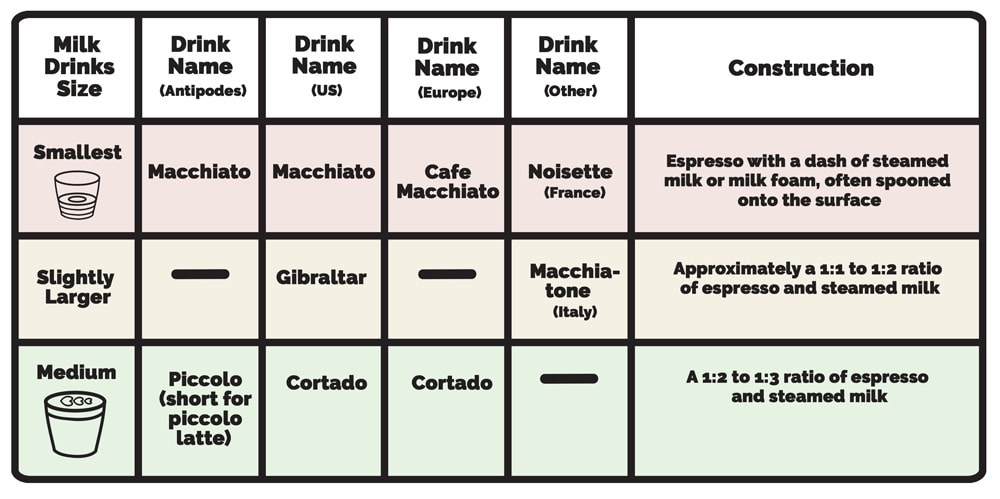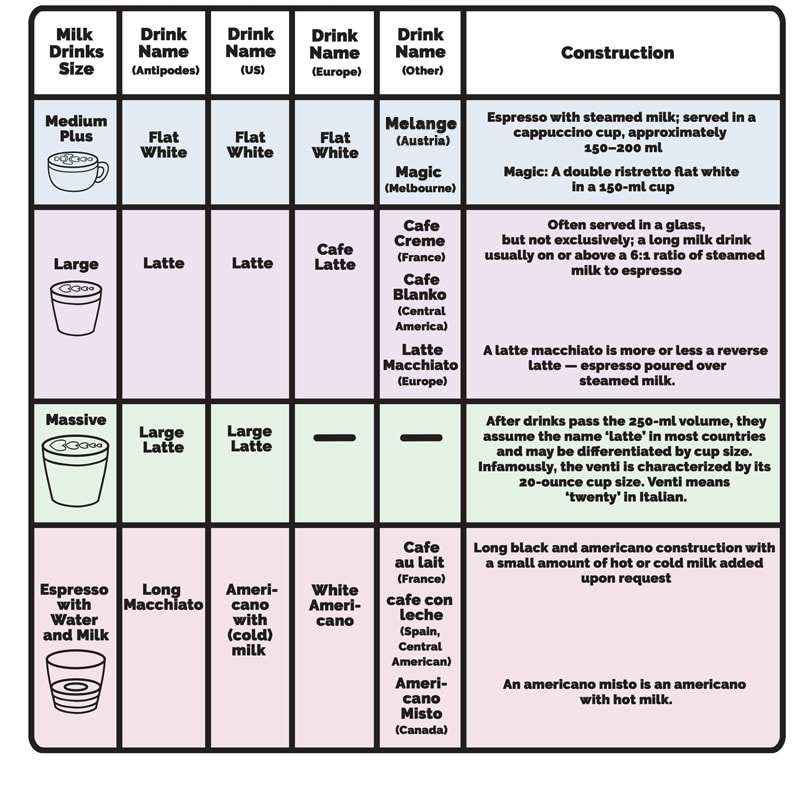I don’t like to stand in front of the coffee bar menu without hinting at drinks. And I’m sure you don’t like it either.
That’s why I wrote this article. Because I want to help you to navigate coffee shops menus at home and abroad. After reading this blog post, you’ll feel more confident when you visit a fancy coffee shop. Even now, espresso bars can get crowded, and it’s annoying not knowing what to order in advance.
I will do my best to explain the difference between these popular coffee drinks appropriately and accurately.
So, without further ado, let’s get to it!
Macchiato: Intensity and richness

A macchiato is a coffee type with an extremely high ratio of espresso to milk. The name can be confusing, but it’s a simple drink. It originates from Italy in the early 1900s when espresso became popular, and Italian baristas wanted a way to create variations on this drink without using two cups. They made the macchiato by topping espresso with a dash of milk, so there wasn’t much time for the foam to form.
Currently, macchiatos are most often made with a shot of espresso and a small quantity of steamed milk to create a layer of foam on its top.
Cortado: Balanced milk coffee

A cortado is an Iberian-style small coffee with a different ratio than Italian-based espresso drinks. The caffe macchiato is also one of the smallest milky coffees: only 4.5 ounces per serving.
It’s a deliciously soft and frothy drink with a delicate texture, and a rich mouthfeel. It’s easy to confuse this drink for a macchiatone. However, most coffee shops today serve a cortado with a bit more milk than a macchiatone.
Flat white: Natural sweetness

A flat white coffee takes two shots of espresso and steamed milk. Although it’s more substantial than a cappuccino, it’s the sweeter among the three, even without added sugars.
If you get used to drinking coffee without sweeteners, you will notice that milk coffees draw some sweetness from steamed milk. Skilled baristas can take advantage of this to prepare delicious cups of coffee, adequating the aromatic profile of the coffee with their selection of dairy and plant-based milk.
Flat White vs. Cortado vs. macchiato: Differences and Similarities
The cortado, the macchiato, and the flat white are three espresso drinks with different backgrounds, origins, and preparations. They look and taste similar tough because the three combine espresso and frothy milk.
All three became famous thanks to the espresso machine and the increasing popularity of coffee shops worldwide, even during COVID.
It’s easier to differentiate the three drinks considering other aspects besides cultural and historical ones.
Origin
Every drink has a story, and these three aren’t the exception. The macchiato, for instance, is part of Italian coffee culture, and it’s an espresso-based drink with lower milk-to-espresso ratio.
Macchiato means “stained.” Baristas usually served it using a dash of steamed milk on top of espresso with a spoon. Initially, the cortado was very similar because the Spanish used to reduce the black coffee strength with a dash of milk or just a slight pour.
Over time, coffee shops have been refining the recipe. Now it’s more common to find a cortado with a milkier and frothier construction.
Regardless of the flat white’s origin, New Zealand and Australia display a distinctive coffee culture. Hundreds of the finest espresso bars in the world are scattered in these two countries, and their aesthetics, refinement, and coffee quality are hard to compare with other places in the world.
The flat white is the most recent among the three coffee drinks, and its popularity has a lot to do with the thriving café culture in New Zealand and Australia.
Size and construction

Image copyright: Barista Hustle
The macchiato is the smallest among the three drinks. More conservative espresso bars serve the macchiato in an espresso cup with a dash of frothed milk. Baristas use a spoon to delicately add only a bit of the microfoam on top of a double espresso.
In more contemporary coffee shops, it’s common to drink macchiatos in a French tumbler. Considering that the top half of the glass is empty, it doesn’t get too hot to handle. The macchiato rarely requires double-walled glasses, but it’s increasingly common to drink it using some of those.
In short, the macchiato has just a spoonful of milk froth more in volume than a double espresso. And that’s a pretty small drink.
The cortado is the next larger. It comes from Spain, but they call piccolo an equivalent drink in Italy.
Overall, a cortado isn’t as tiny as a macchiato. Depending on the coffee shop recipe, it has a ratio between 1:2 and 1:3 of espresso and steamed milk. If the coffee shop uses a double espresso for it -which isn’t as rare as you might think- it’ll make quite a difference for a stronger and more intense taste.
When researching another article about cortado, baristas consider it a popular drink after lunch because it’s smaller than a cappuccino. And I agree. A cappuccino is too heavy to have when you’re full, but a cortado has that frothy, smooth texture that we love in milk coffee drinks.

Now, the largest among the three drinks is the flat white. It’s hard to know who created the flat white, despite having just a few decades on the market. The flat white is a great invention because it’s halfway between the cortado and the cappuccino.
Like cappuccino and latte, large coffee drinks, the flat white can have between 150 ml and 200 ml, depending on the café. The espresso-to-milk ratio varies primarily because of the size of the cup. Usually, the flat white takes a double shot of espresso, and the barista fills the rest of the cup with steamed milk.
Many cafés serve the flat white in a French tumbler, although drinking a flat white in a cappuccino cup isn’t rare.
Body, milk, and texture
The frothiest between the cortado, the flat white, and the macchiato tends to be the flat white because it has more milk than the other two.
Additionally, it tends to display a larger latte art drawing due to the size of the cup. The cortado looks adorable, and it’s the second in terms of its frothy texture.
The macchiato is the less frothy of the three. The macchiatone, which is halfway between the macchiato and the cortado, is slightly frothier and milkier. In some coffee shops, you can find the macchiatone as a valid substitute for the cortado. Still, most traditional espresso bars will identify a macchiatone as having a 1:1 espresso to milk ratio.
Coffee shops that offer different types of plant-based milk can froth them to serve all three drinks.
Conclusion
The difference between the macchiato, the cortado, and the flat white boils down to size and espresso to milk ratio.
For a small drink with a very intense taste and little milk, go for a macchiato. If you want a frothy cup of coffee, but not as large or heavy as a cappuccino or a latte, go for the flat white. If you want a small cup of coffee, still as bubbly as the latter, go for the cortado.
It’s that simple!
And if you’re planning to learn how to make flat whites, cortados, macchiatos, and other espresso drinks at home check our espresso machine buying guides.



Great article well explained. Easy to understand what is a far more complicted topic than I had thought it would be.
Thank you.
Thanks for your encouraging comment. I’m so happy it was helpful for you!